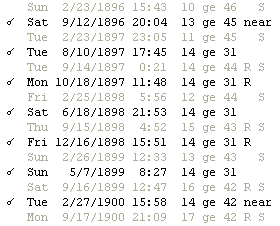
| What Watch? - Tutorial | Next chapter: Lunation cycles | Back to First Page |
Transits, Progressions and Solar Arcs
Finding the exact timing of transits was the first reason why I started to work on What Watch back in 1999. The transits of the slower planets are particularly interesting. Changing between direct and retrograde motion, they activate a transit point up to five or even seven times. I felt the necessity of watching these transits more closely and to understand their effects on the quality of time when Pluto hit my natal Venus/Mars conjunction a couple of years ago. Unfortunately, although I use quite expensive astrology software, I did not find the kind of exact analysis tool I was looking for. So I started coding myself.
Transits in What Watch
The first step to find the transit pattern you're looking for is to identify
which are the planets being active at a given moment. Put the transit chart into "Wheel
One" (or just press "Now",
if you're interested in what's going on in the moment). Put the natal chart into "Wheel
Two".
If you look at the synastry in Wheel Two, you see the natal chart in black and
the transiting planets in red. Click on a planet to see more details on the
aspects it is forming.
Or use the harmonic aspectarian: The following example shows the transits for Sigmund Freud on his 42nd birthday, 6 may 1898.

Look at transiting Pluto. It's about one degree away from the natal Moon. As the glyph is not underlined, the planet is in direct motion, it moves from the left to the right in the harmonic aspectarian. Pluto is about to begin its transit. But at what phase in the transit are we? Is it the first time that Pluto contacts the Moon? Or is it one in a whole series?
 |
To find out, go back to the "Data" tab. Select the Moon as birth planet, Pluto as transiting planet and press "List". You'll get a long list, a part of which is shown on the left. You can see that this Pluto over Moon pattern is a long one that started already in 1896 when Pluto first came into orb, but stationed before reaching the exact transit position. So now, in May 1898, Freud had already experienced the transit in direct and in retrograde motion. So he is right in the middle of a long strenuous time in his life. |
What Watch gives even more info on each transit. Just click on the line of the transit you're interested in - the date when the transit enters and leaves orb (one degree) is shown, as well as the corresponding Sabian symbol for the transit degree. Click on the text again, and it will disappear. If you click with the right mouse button, the full transit horoscope is calculated: if you are working on chart "One", the transit chart is loaded into tab "Two", and vice versa.
Secondary Progressions
This method works as well for progressions. Select a progression as transiting
planet, and you can work with the resulting list as with any other transit list.
When you right click on a progression to look at it in more detail in a wheel,
you'll remark that the planets are shown in green to indicate that it's not a
birth chart with transits, but a progression.
You can also select this option manually to calculate progressions for any given date. Please keep in mind that a progression always needs a birth chart as reference. So, once you've loaded a birth chart in, say, tab "One", select tab "Two", choose your date and press the "P" button. The progressed chart can be viewed in synastry with the birth chart, and be analysed using the harmonic aspectarian.
Transits and progressions can be combined in one chart wheel. Press the "T/P" button: Sun, Moon, Mercury, Venus, Mars and the axes and houses are calculated as progressions and shown in green, all other planets are transits.
Solar Arc Directions
What Watch can also calculate solar arc directions. Select a planet's solar arc
as transiting planet, and again, you can work with the resulting list as with
any other transit list. Similar to progressions, use the "D" button to find
out solar arcs for a given date. Solar arcs are shown in blue.
Literature:
Robert Hand – Planets in Transit, Whitford Press: Atglen PA 1976
Liz Greene – A Psychological Approach to Transits and Progressions, in:
The Horoscope in Manifestation, CPA Press: London 1997
Dane Rudhyar – Progressions in Astrology, in: Horoscope Magazine, 1965
(available today from www.khaldea.com)
Steven Forrest – The Changing Sky, ACS: San Diego CA 1989
Erin Sullivan – Retrograde Planets, Penguin (Arkana): London 1992
| What Watch? - Tutorial | Next chapter: Lunation cycles | Back to First Page |